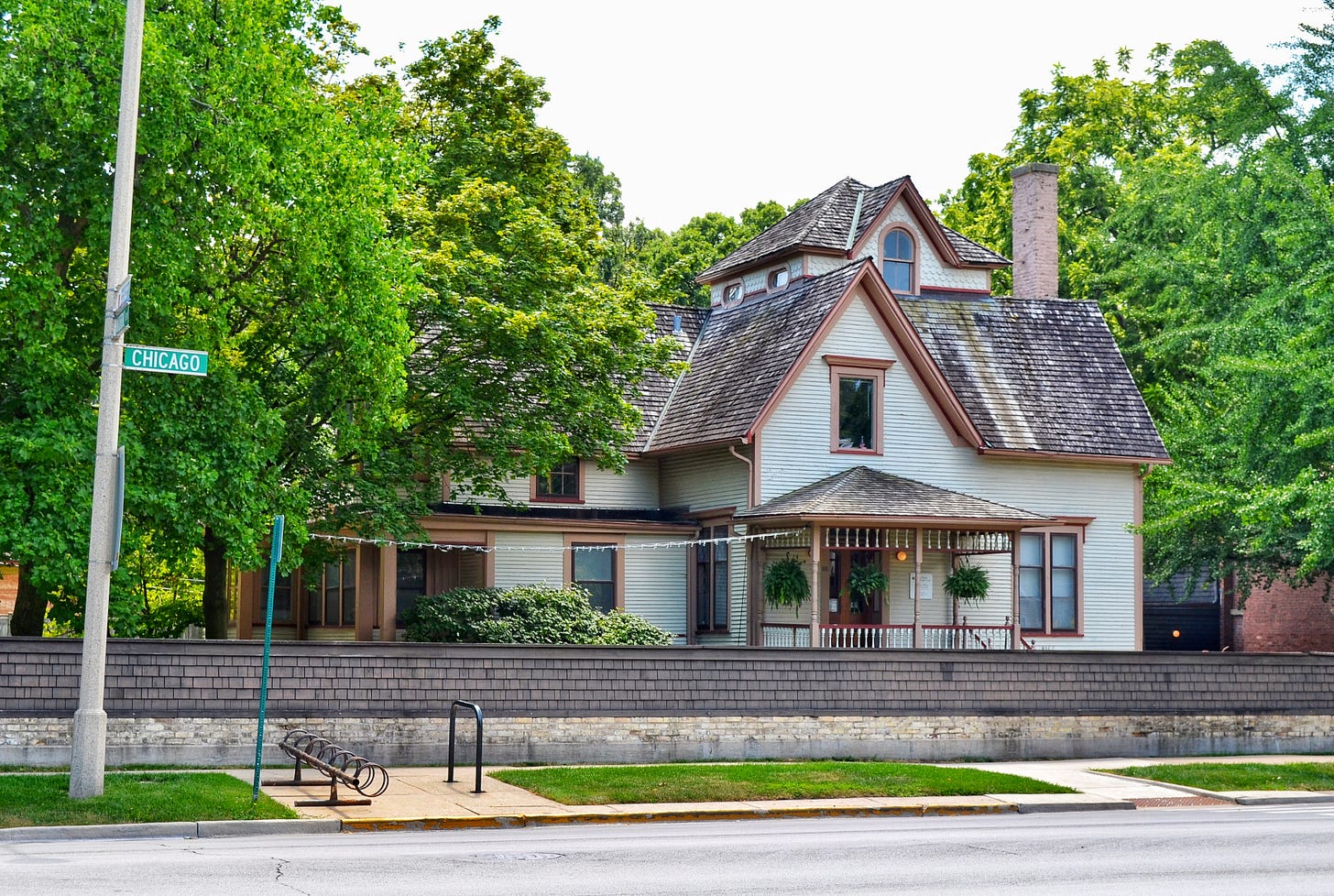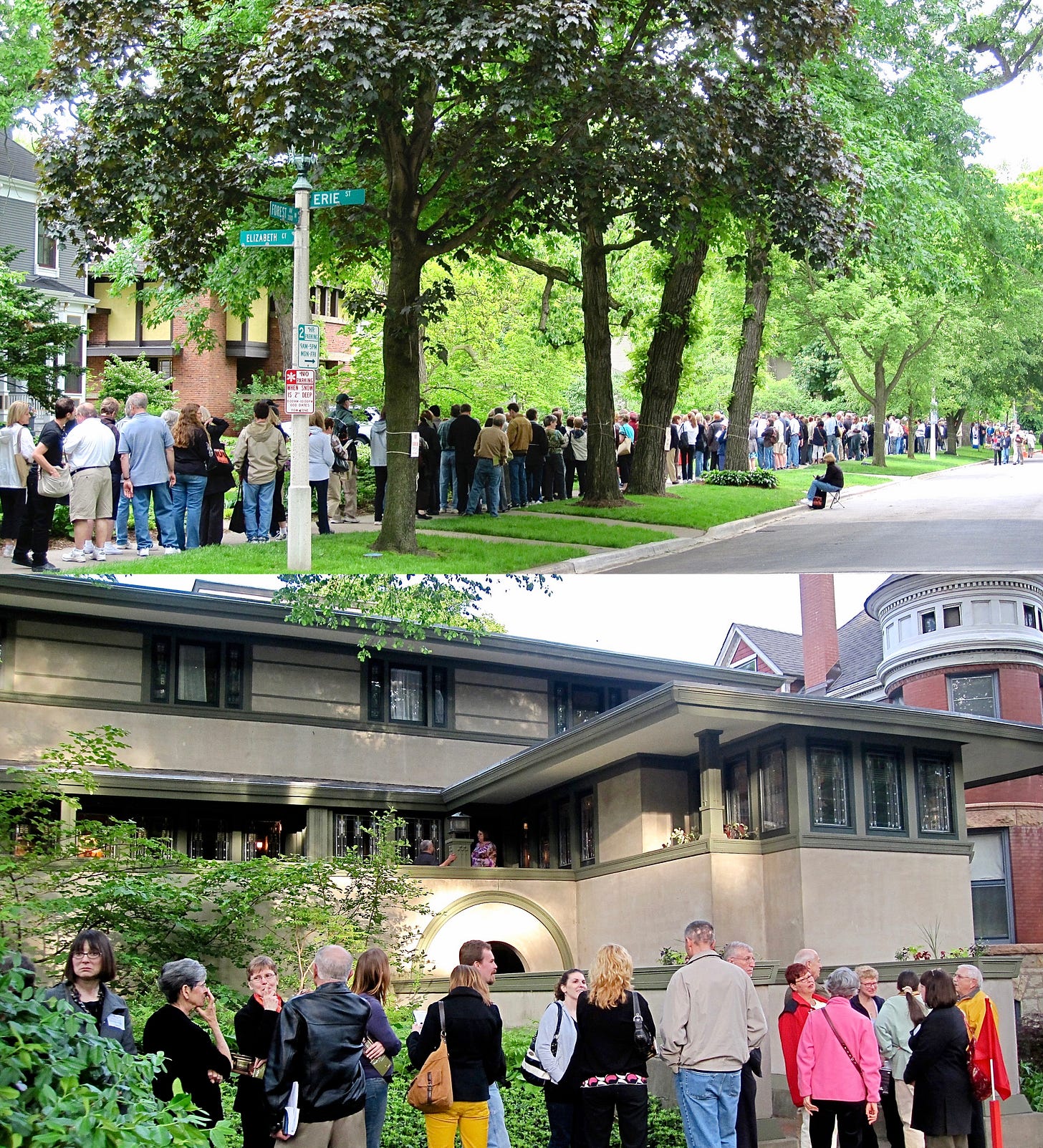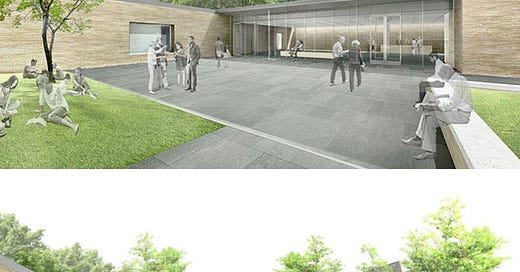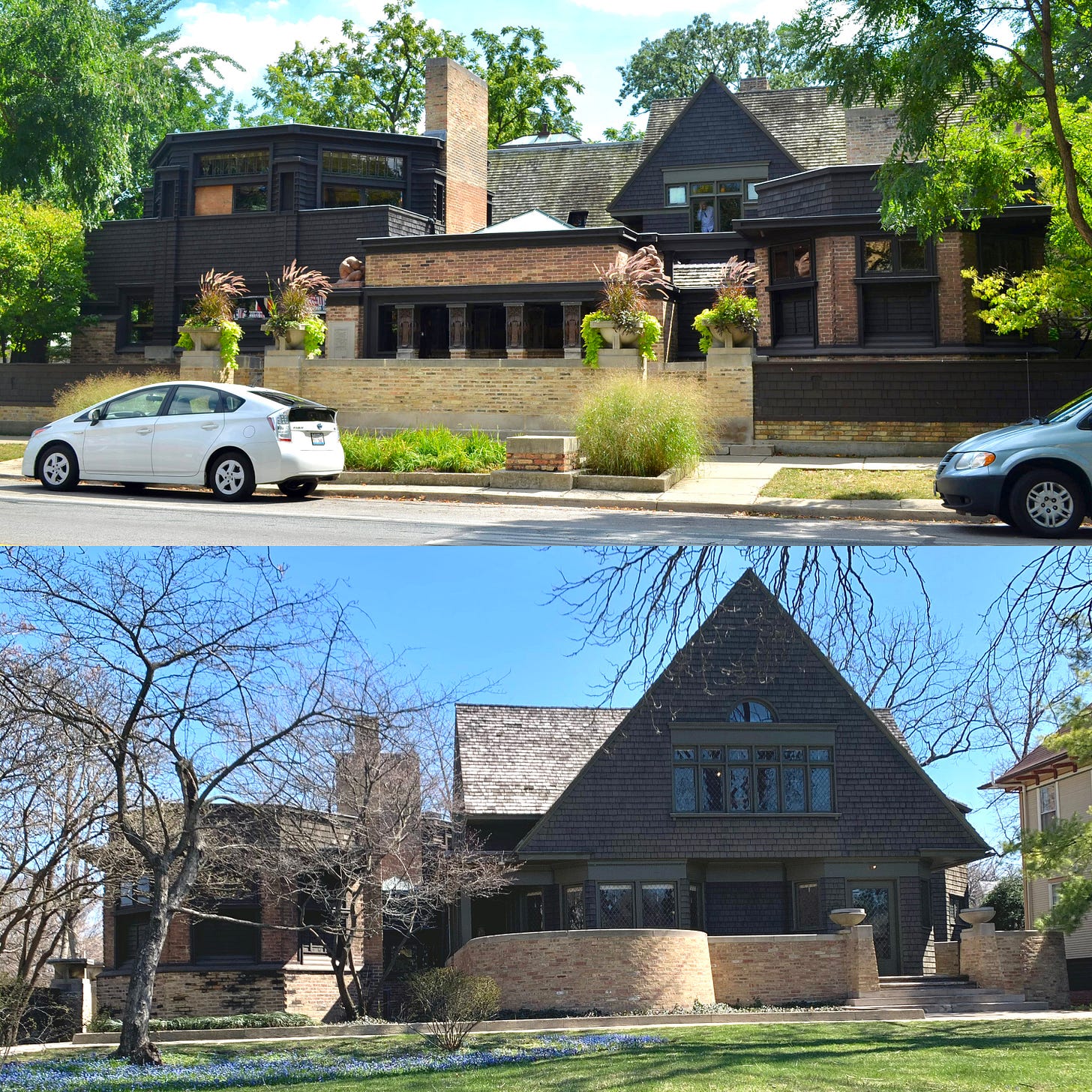I started the year by looking back at a handful of demolitions I documented in 2021. But what about demolition by neglect? This is a somewhat common practice used by numerous property owners and developers across the country who let a building deteriorate to the point that demolition is absolutely required. The strategy is one of the toughest preservation issues we face today. Lack of maintenance is apparent for all to see, and unless there are strict local ordinances that protect historic structures from decay and abandonment, not much can be done to stop demolition by neglect.
That’s why the current status of the 1888 Italianate at 925 Chicago Avenue in Oak Park is so frustrating. It currently has no heat, the paint is peeling, a worn roof, clogged gutters, and until recently a tree growing at its roofline. Located in the middle of Chicagoland’s most visited historic district, this contributing property was bought by its neighbor directly to the west - the Frank Lloyd Wright Trust - for $340,000 in December of 2017. They initially said there were no plans for the old building, which extended their street frontage to 400 feet along Chicago Avenue, then suddenly proposed a brand new, multi-million dollar Visitor and Education Center in its place. With 20,000 square feet of indoor and outdoor space, the Trust argued the John Ronan design would help them expand their programming and would be “set gracefully into the context of a beloved historic site and neighborhood.” The former FLW garage, now a gift shop, would be turned into a gallery while his mother’s residence, an 1866 Folk Victorian known as Anna’s House, would be adaptively reused as a library and research center. Wright, who bought the home for his mother, might have been involved with its additions. FLW Building Conservancy expressed concern that “demolition of these portions would remove evidence for further study.”

In my personal opinion the whole plan reeked of superficial glitz that was completely out of tune with its surroundings, which is mainly residential with an elementary school directly across the street. So I wasn’t surprised when the proposal proved to be controversial amongst not just locals and neighbors, but also architects, the FLW Conservancy, and the National Trust (the former owner of the FLW Home & Studio). Volunteers of the FLW Trust argued on social media this new building was completely necessary because “an elderly gentleman peed his pants on my tour last week.” Yes, trying to manage what at the time was 90,000 visitors a year with only a couple of bathrooms is indeed a problem, but ultimately a weak argument for why the project had to proceed. All the educational programs, lectures, gatherings, and housing of archival materials can easily take place elsewhere.

In September of 2019 the Oak Park Preservation Commission rejected the proposal. Some volunteers weren’t too happy with some saying “preservation has gone too far.” Isn’t historic preservation the reason why people from all the over the world visit Oak Park? The FLW Trust accepted the decision with a statement from President & CEO Celeste Adams claiming they would be “responsible stewards” of their historic sites. But did she just mean the Wright-designed ones? That is where the demolition by neglect part comes in as the FLW Trust have allowed the historic Italianate to fall into disrepair, probably so they can argue later that it can’t be rehabilitated or reused. How sad that an organization once closely linked with the local community and historic preservation efforts has gone this way, becoming a shell of its former self. The “preservation” part of their original name was dropped by the FLW Trust awhile ago.
And it’s no surprise Adams is part of that change - unlike her predecessor Joan Mercuri, she doesn’t have her office in Oak Park but instead is based at the Rookery in downtown Chicago. It further removes her from the everyday concerns of the local scene. I do not see her motives as pure. I see this pet project of hers as a typical move by executive directors of cultural non-profits, only focused on growth and trying to leave their mark in a big way. If the organization is truly concerned about the future of the Home & Studio, an officially recognized U.S. National Historic Landmark, did they ever stop and think that all this growth isn’t a good thing? The Trust says they *have* to build a new center due to congestion and the inability to accommodate an overwhelming number of visitors (at least pre-COVID) but aren’t they to blame? Like Venice limiting the number of tourists to their city, the Trust can restrict access to the Home & Studio. They have lost sight of protecting this one-of-a-kind structure, and instead are too focused on money and growth.

Why am I so passionate about this issue? One of my earliest memories related to architecture was visiting Frank Lloyd Wright’s Home & Studio as a little kid in the 1980s. The property, which had been saved and restored by a group of volunteers who established a 501(c)(3) organization and opened it to the public in July of 1974. Even as a child I was a total history geek, so I paid attention to everything the docent said during the tour. I remember being very upset when I found out Wright left his family, leaving them with hardly any money. Catherine Wright and her children were forced to move into the studio space and rent out the house for income. Supposedly I said to my mom and her friend, “He doesn’t sound like a very nice man.” Somehow I would forget that fact when I joined the cult of Frank Lloyd Wright around 2002.

I was looking for volunteer activities while I attended DePaul University even though I was balancing a full-time schedule as a student (the school is on a 10-week quarter system) while also working two part-time jobs. After taking an architectural history class I thought “Hey, I like this!” I was also moving towards the possibility of becoming a museum educator, which didn’t really work out but that’s a whole other story. I was excited to join up with this small non-profit organization, which seemed like a family. I learned so much about Wright and the Prairie School and was happy to share that information with the public. I ended up getting a job there, not just once but twice. I got to meet a lot of interesting people, some of them became good friends. But things went bad for a number of reasons, which I won’t get into here. I will say that I wasn’t the only one who left on unpleasant terms, whether as an employee or volunteer. My eyes are more open now that I have left the Trust circle.

What I have found really disappointing are the significant changes related to the organization’s mission. What had started out as the “hole-in-the-wall gang,” a small group of volunteers who helped save and restore the FLW Home & Studio, has gone corporate, only interested in power, growth, and money. The modern visitors center is a perfect example of that. And so is their huge annual fundraiser, the Wright Plus Housewalk. People shell out big bucks (we’re talking almost $3000 per person for the ultimate weekend package) to attend this event where you have the opportunity to go inside a handful of private homes. I’ve heard through the grapevine they oversell tickets, which is why lines to get inside these houses can be hours long. People are exhausted by days end, and that includes the army of volunteers who put together Wright Plus every year. It’s a shame that so many individuals continue to volunteer their precious time and spend their hard-earned money by supporting the Trust, so flush with cash their CEO makes six figures (while laying off some of her non-profit staff during the pandemic) and can purchase properties only to let them rot.

Oak Park’s Frank Lloyd Wright-Prairie School of Architecture Historic District is like walking through an outdoor museum where you can see nearly all the architectural styles popular during the 19th and early 20th centuries. As someone who used to give walking tours up and down Forest Avenue, context matters. If you surround Wright’s earliest buildings with contemporary structures, you rob the designs of their impact. Wright’s residences become all the more poignant when seen in the environment and time period in which they were built, sitting side by side with Victorians and Colonial Revivals. Vernacular buildings like the 1888 Italianate deserve to be preserved as much as the Wright designs. The FLW Trust should not be allowed to pick and choose what structures are deemed “more important” in the middle of a historic district. It reminds me what future governor Ronald Reagan said in 1966 when asked about the conservation of the redwoods in California: “If you’ve looked at a hundred thousand acres or so of trees — you know, a tree is a tree, how many more do you need to look at?” If we tear down one tree, who says more trees won’t follow?






Was pointed to your article on Krause (I used to live a few blocks from it), and was suggested this article. I am a Chicago Architecture Center docent who has given the FLW in Oak Park walking tours for more than 10 years (and downtown walking tours for more than 10 years before that), and a resident of Oak Park. I don't know much about the Home & Studio organization's changes and priorities and values. Without a doubt, they made a massive mistake not involving the neighborhood in the planning and discussions. In Oak Park, that’s a cardinal sin.
But to me, the visitor center would have been a great addition. It would be great to have a modern check-in facility to spread people out or get out of the rain and yes, have more than one person for the 100+ people per hour going through the home. Programming could also have been expanded.
Opponents talk about the historic district or neighborhood as if it's been under glass for 120 years. It has not. And a walk down Kenilworth you see the stately Victorians from the 1800s flanked by mid-century ranches. Holmes school across the street is a brick mid-century design with a tasteful modern addition. There’s a great mid-century apartment building on the NW corner of Forest and Chicago, across the street from the H&S. Even the Laura Gale house is particularly not of the area’s era. Like downtown Chicago, Oak Park is this fun mix of Victorians, Gundersons, courtyard apartments, bungalows, workers' cottages, mid-century structures, and even the great new high rises downtown, like Albion.
(I particularly love the home at the end of the cul-de-sac at Elizabeth and Kenilworth. They took a tiny little house and added a modern addition that looks straight out of an Audi commercial. Plus, the windows and trim facing Kenilworth look like the house is smirking at the pretentiousness of the mansions.)
The Ronan design would have quietly bordered the property, enabling the H&S, gingko tree and mother’s house to be the stars.
I reject the idea that demolishing this one house would lead to a slippery slope of more and more demolitions. The Trustees could have approved this because it’s a demolition of an insignificant (but OLD!) building for the benefit of strengthening a cultural institution and important economic driver. I’m not sure how many other situations like this could exist in Oak Park.
Wright himself would likely have wanted the modern center. In researching my tour, I came across an interview where Wright was asked about the reputation his buildings had for poor quality. And he basically said "Buildings are made for the culture and life and technology of the time they are built. No one will want to live in buildings like these in 50 or 100 years – the world will have evolved. So it doesn't have to last."
Maybe the H&S is doing demolition by neglect. I do not think the H&S is flush with cash from foundations or benefactors. So when you can’t give tours for two years, yes, you have to let staff go and save your cash for maintaining the core home and studio. How much will it cost to renovate the house? Where will that money come from? Should they hire staff back or replace its roof? Should they divert $$$ from H&S maintenance to this structure? (I also do not support this idea of historic preservation for archaeological study of structures not truly significant. You should be able to replace wood clapboard with Hardyboard on a house in an historic district if it doesn’t alter the appearance.)
(It’s funny, this house reminds me of the old WMVP 1000 Kevin Matthews satire of classic rock radio stations: “Don’t have to be good to be a classic!”)
Regardless, enjoyed the Krause story and looking forward to digging into the past and future content as a subscriber.